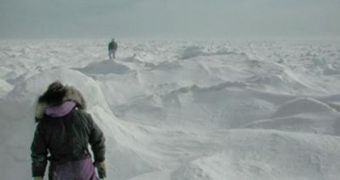According to a new satellite survey of the Arctic region, conducted by NASA, the University of Colorado in Boulder (UCB) and the US National Snow and Ice Data Center (NSIDC), the ice shelves at the North Pole are getting smaller and thinner. The decade-long trend of melting is thus appearing to continue, with no end in sight. These results again contradict those that say that global warming is nothing but a hoax, who claim that the melting in the Arctic, Antarctica and Greenland is only temporary, and that the planet will heal itself.
NISDC researcher Walt Meier stresses that all of the recorded annual minimums in terms of ice extent have been registered over the past 6 years, with the winter of 2008-2009 being the fifth in terms of ice loss. The expert also adds that the largest measured extent of ice for this winter was recorded on February 28th and that the shelves measured 5.85 million square miles, a 278,000 square-mile decrease from the average levels recorded between 1979 (the year when Arctic surveys begun) and 2000, when global warming really started taking a turn for the worse.
“Ice extent is an important measure of the health of the Arctic, but it only gives us a two dimensional view of the ice cover. Thickness is important, especially in the winter, because it is the best overall indicator of the health of the ice cover. As the ice cover in the Arctic grows thinner, it becomes more vulnerable to summer melt,” Meyer explains. Over the past few years, “young,” thinner ice has replaced “older,” thicker shelves, which means that the new sheets are more prone to melting in the summer than the previous ones.
“Heading into the 2009 summer melt season, the potential continues for extensive ice retreat due to the trend toward younger, thinner ice that has accelerated in recent years. A key question will be whether this second year ice is thick enough to survive summer melt. If it does, this might start a trend toward recovery of the perennial sea ice pack. If it doesn't, then this would be further evidence of the difficulty of re-establishing the ice conditions that were typical of 20 or 30 years ago,” James Maslanik, a research professor at CU's Aerospace Engineering Sciences Department, points out. He is also a member of the Cooperative Institute for Research in Environmental Sciences, and the leader of a 2008 study on the Arctic, published in the journal Geophysical Research Letters.

 14 DAY TRIAL //
14 DAY TRIAL //